Art
Advertising
- Advertising
- Tin (Cassiterite) Distribution: Mediterranean Bronze Age
- Archaeological Sites of the Aegean Minoans
- Extent of Santorini Eruption's Tsunami Inundation of Minoan Crete
- End of Minoan Linear A Writing and LM IB Fire Destruction of Crete
-
The Cause of the End of the Bronze Age
with the Scientific Method -
Nature Geoscience Journal and
Late Minoan IB Destruction Event - Prehistoric Star Navigation, Eastern Mediterranean Ethnocentric Bias, and the "Cabal of Certainty"
- Theoretical Bronze Age Minoan Heliographic Aegean Network Validated by 92.15 Mile (148.3 Km) Mirror Sunlight Flashes
- The Validation of a Bronze Age Minoan Heliographic Aegean Network in Southern California
- Tsunami Generation from the Titanic Bronze Age Minoan Eruption of the Santorini Marine Volcano
- The Cento Camerelle Mines of Tuscany: A Major Bronze Age Source of Tin
- No Men or Sails Required: Successful Prehistoric Sea Travel
- Minoan Downfall and Volcanology's Black Hole of Unknowns
- Homer and Navigating by the Stars in Prehistory
- Primacy of Human Powered Rowing in Copper Age and Minoan Shipping
- Minoan Invention of the True Dome and Arch Prehistoric Mediterranean Catenary Architecture
- "Sinking Atlantis" Tsunami Myth Debunked
- Minoan Tholos Structural Mechanics and the Garlo Well Temple
- Minoan Web of Mirrors and Scripts
- Santorini Eruption and LM IB Destruction
- Minoan Catastrophe: Pyroclastic Surge Theory
- Early Minoan Colonization of Spain
- Origin of the Sea Peoples
- Minoan Ship Construction
- Minoan Maritime Navigation
- Ringed Islands of Thera, Santorini, Greece
- Minoan Scientific Tradition
GIS Google Earth
Publications
Publications
Official Art Gallery
A Collection of 20 Paintings each with over 70 Art Products
For some time now, every couple of years, a rowing race across the Atlantic Ocean is held after the end of the hurricane season from the Canary Islands to the West Indies. This year's race starts on December 14, 2015. The Atlantic Challenge website provides all the information anyone could need on the rules, rowers, and their boats along with the ability to track (24/7) their progress across the ocean. Additional video coverage of the 2013 race, including the full documentary, can be found below.
Click on Image to Play Video

Talisker Whisky Atlantic Challenge 2015 - Promotional Video (2:16)
As a young teenager of about 14 I spent a summer on the Chesapeake Bay in the US as a "sea" scout. The boats we crewed were old salvaged ocean liner lifeboats that were about 10 meters in length with beam widths of a little over three meters that had been fitted with a single mast and rigged with a square sail. More importantly there were five rowing stations on each side of the boat. Basically they were much smaller versions of the Minoan long ships depicted in the Miniature Frieze from Akrotiri.

Minoan Ship with Rowers Only
Minoan Miniature Frieze Admirals Flotilla Fresco
Shipping Scene
Late Bronze Age (LBA)
Neo-Palatial Late Minoan I Period
West House, Room 5, South Wall
Akrotiri, Santorini (Thera), Greece
Minoan Miniature Frieze Admirals Flotilla Fresco
Shipping Scene
Late Bronze Age (LBA)
Neo-Palatial Late Minoan I Period
West House, Room 5, South Wall
Akrotiri, Santorini (Thera), Greece

Minoan Miniature Frieze Admirals Flotilla Fresco in Three Panels
Late Bronze Age (LBA)
Neo-Palatial Late Minoan I Period
The West House, Room 5, South Wall
3.90 x 0.43 meters
Akrotiri, Santorini (Thera), Greece.
Late Bronze Age (LBA)
Neo-Palatial Late Minoan I Period
The West House, Room 5, South Wall
3.90 x 0.43 meters
Akrotiri, Santorini (Thera), Greece.
While there is one ship in the frieze that is powered by a single square rigged sail only, the six other large ships shown are powered by humans levering their oars in the water. In a precision restoration of a scene from the middle of the frieze I did a few years ago you can clearly count 21 oars on the side of the most "decorated" long ship giving it a total of 42 rowing stations. This must have been a very big ship indeed. Of the frieze's six large rowing vessels only two have a single mast but no sails are deployed. This is very strong evidence for the great importance of human powered rowing in Minoan shipping.
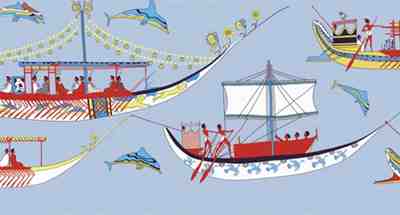
Minoan Miniature Frieze Admirals Flotilla Restoration Fresco
Shipping Scene
Late Bronze Age (LBA)
Neo-Palatial Late Minoan I Period
West House, Room 5, South Wall
Akrotiri, Santorini (Thera), Greece
Shipping Scene
Late Bronze Age (LBA)
Neo-Palatial Late Minoan I Period
West House, Room 5, South Wall
Akrotiri, Santorini (Thera), Greece
As a sea scout I quickly learned that the sail was wonderful if the wind was in our favor in taking us to an appointed destination and we would use it as much as we could. But if the wind was unfavorable we would simply take the sail down and row straight into the wind if necessary. Only the strongest winds could stop us from rowing directly into them. In time we became rowing machines that could literally work the oars all day long and well beyond without any problem at all.
Our human powered oars were always the primary and most reliable power for our boats just as they would have been for the Bronze Age Minoans and the many Mediterranean seafarers that came before them.
Our human powered oars were always the primary and most reliable power for our boats just as they would have been for the Bronze Age Minoans and the many Mediterranean seafarers that came before them.
May 30, 2016
W. Sheppard Baird
Copyright © 2007, 2024 W. Sheppard Baird
All Rights Reserved
All Rights Reserved
-

Minoan Ship with Rowers Only
Akrotiri, Santorini (Thera), Greece
-

Minoan Ship with Sail Only
Akrotiri, Santorini (Thera), Greece
-

Minoan Miniature Frieze
Admirals Flotilla Fresco
Shipping Scene Restoration
West House, Room 5, South Wall
Akrotiri, Santorini (Thera), Greece
-

Mediterranean Sea
-

Minoan Dolphins Restoration Fresco
Knossos, Crete, Greece
-

Minoan Octopus Fresco
Knossos, Crete, Greece
-
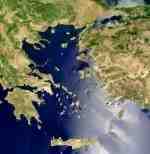
Aegean Sea
-
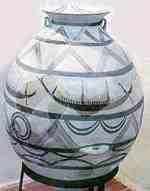
Aegean Vase with Ship Figures
1700BC
-
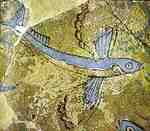
Minoan Flying Fish Fresco
Phylakopi, Milos, Greece
-
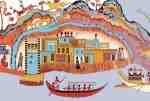
Minoan Miniature Frieze
Admirals Flotilla Fresco
Thera Restoration Scene
West House, Room 5, South Wall
Akrotiri, Santorini (Thera), Greece
-

Spring Fresco West Wall
Swallows Scene
Akrotiri, Santorini (Thera), Greece
-

Minoan Ladies in Blue Fresco
Knossos, Crete, Greece
-

Minoan Dolphins Fresco
Knossos, Crete, Greece